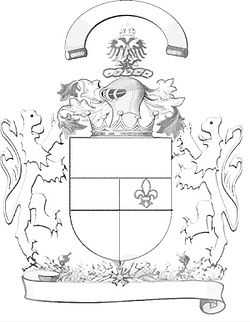Torse

In heraldry, a torse or wreath is a twisted roll of fabric laid about the top of the helmet and the base of the crest. It has the dual purpose of masking the join between helm and crest, and holding the mantling in place.
It was originally a protective pad worn under a knight's coif and helmet, covered by a pair of ribbons, of the principal tinctures of the shield or of the armiger's livery colours, twisted together and extended far enough down the back to be seen beneath the helmet from the rear.

The torse is sometimes mistakenly said to be the token, such as a handkerchief or sleeve, which the knight’s lady-love gave him to wear when he left for the wars or participated in tournaments. This is due greatly to its original use being lost to history as the heraldic crest became more and more stylized and less representative of actual use.
The torse is blazoned as part of the crest. For example, the crest of Canada is blazoned On a wreath of the colours Argent and Gules, a lion passant guardant Or imperially crowned proper and holding in the dexter paw a maple leaf Gules. The tinctures of the torse are generally not mentioned in the blazon, as they are assumed to be of the principal metal and colour in the shield. Like the mantling, it must always be of a metal and a colour; usually the torse and the mantling are the same tinctures. In British heraldry, the torse is generally shown with six twists of material, alternatively metal and colour.[1]

Occasionally the torse is replaced by a crown or coronet, which is then termed a "crest-coronet". In the past this practice was widespread amongst all ranks, but is nowadays usually denied to those outside the royalty and peerage, except in special circumstances. Some commoners have bypassed this rule by placing a coronet on top of a torse, rather than in place of it.

The torse is also often used as a decoration on a heraldic animal, either across the brow (as a form of circlet) or around the neck. Moors and Saracens are also traditionally depicted in heraldry with a torse across their brow.